Friday, April 16, 2010
Oooo...fun! A Giveaway!
So, usually this Friday spot is occupied by a wonderful fiber artist. I decided to shake things up a little bit and do a giveaway instead. I highly doubt there will be any complaints!
You might be asking, "Who is the illustrious fiber artist that is sponsoring the giveaway?"
Well, I decided to hit up someone I know very well and have been following her work for years. O.K., it's me!
Your next question is probably, "What's the loot?"
The 'loot' is one of Desert Dyeworks Starburst Mandala Playsilks. Specifically, this one.
So, how does one enter to win this playsilk. It's pretty simple. Leave a comment below, making sure you add your email address in the appropriate box so that I can contact you if you're the winner. Don't worry, I won't use it to spam you, I prefer Bacon! The giveaway ends at Midnight(12:00a.m.) PST on Friday April 30th, 2010. Winners will be chosen at random. I will get in touch with the winner within 24hrs. of the contest ending and the winner will have an additional 72hrs. to get in touch or a new winner will be chosen.
Speaking of Bacon! A second chance to enter the giveaway is to head over to Esty's Team Bacon! blog, check out one of my team members shops, and leave a second comment here with a link to your favorite item from that team member's shop. Gotta give my team member's props because they are the bacony best!
Alrighty then, get to it!
Labels:
Dsert Dyeworks,
Giveaway. etsy,
mandala fold,
play silks,
playsilks,
star,
Team Bacon
Friday, April 9, 2010
Friday's Fiber Artist - Hidow Fiber Farm
So, after learning a little bit about her farm and fiber art plans for the Summer, my daughter and I have decided we are moving in with Hidow Fiber Farm! She doesn't know this yet, but we are very excited to shear some Alpaca, spin some fiber, and dye it using the luscious Summer flowers around the farm.
Seriously, despite the hard work that goes into raising these animals, who wouldn't dream of being that close to the source of all that luscious fiber? In my mind it's akin to knowing and being apart of where your food comes from.
Alpaca are bred all over the world for the soft and silky fiber that is produce from its coat. Originally Alpacas were kept as domesticated in the South American Andes, where they were a primary source of fiber for textiles as well as a source for meat. Though, the use of Alpacas for meat in modern times is virtually non-existent, Peruvian law prohibits it.
Alpaca fiber is a wonderful alternative to sheep's wool. It is generally not prickly like sheep's wool and contains no lanolin, which makes it hypoallergenic. The two primary breeds of Alpaca bred today are the Huacaya and Suri. The Suri is identified by its long 'dreadlock'-type fleece, which produces longer silky fibers. Huacaya have a denser, 'woolier' fleece.
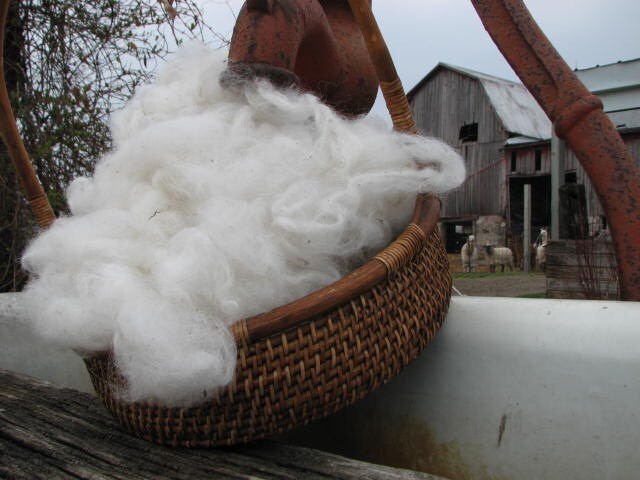 |
| Huacaya Fiber from Hidow Fiber Farm |
A passion for man's best friend, dogs (sorry cat lovers!), inspires many of the needle felt creations in the Hidow Fiber Farm's Etsy shop. I especially love her Samoyed pup. The big tail flopped to the side gives it a wonderful personality!
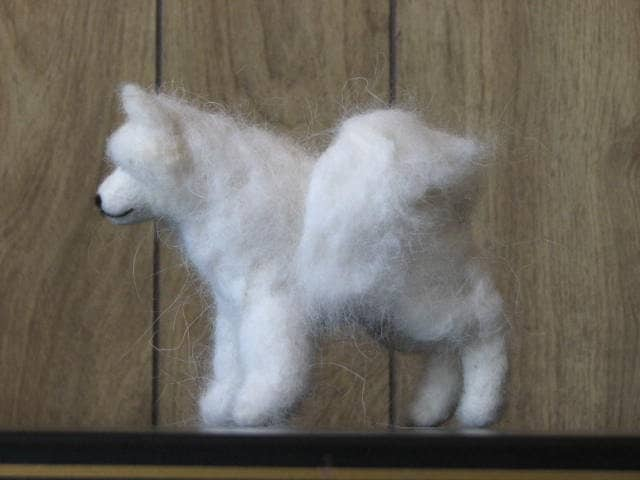 |
| Needle Felt Samoyed by Hidow Fiber Farm |
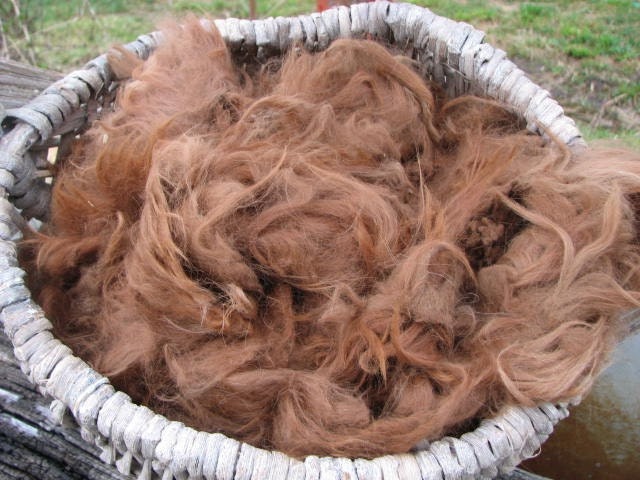 |
| Brown/red Suri Fiber by Hidow Fiber Farm |
"Hidow Fiber Farm is located on over 100 acres in the Thumb area of Michigan. Our farm has been in the Hirons family for over 125 years. Grandma and Grandpa Hirons only had girls, so when we bought the name changed to Dowling. The name of Hidow was thought up by Grandma, it was her way of combining the family names to represent the farm, we have kept it in her honor.
I have always been interested in the process of fleece to yarn, and I dreamed of learning to spin someday. While showing dairy goats around the country I used to love watching the llama and alpaca shows and visiting the alpaca area but because of their prices never dreamed I would own one. Two years ago the dream of owning an alpaca became reality. My first 3 Huacaya alpacas were rescues, traded for bales hay. Soon after, the local alpaca herd was selling out and I added several. This spring I bought another 5 Suri fiber males. Currently we have a total of 13 Huacaya and Suri Alpacas and a flock of Shetland sheep.
I jumped into the fiber world with both feet, even before I had any of my own to play with. A drop spindle bought from ebay along with some fiber and You Tube videos taught me how to use a spindle. Then I found an alpaca site with felting so I started researching that area of fiber art. Some locally made goat milk soap and some fiber from ebay and we had felted bars of soap. Then I made the trip over to Zielingers in Frankenmuth and brought home a needle felting kit. A trip to Mary Maxim where I bought several books and a needle felt kit to make a dog. Then I found the "Felt a Dog" book for even more inspiration. With the basics in place I got braver and started 'needleing' (as my 6 yr old calls it) my own creations. I love feeling and watching a dog or other animal take form in my hands. I start with a roll of fiber and just keep adding a little fiber here, a little there and soon I have a sculpture. There are times when I think a project is finished and put it away only to pull it out a few days later and realize there is more to be done with it. Because I also show dogs I try to base my fiber creations on correct representatives of the breed.
It is spring time so that means that right now I am enjoying the process of harvesting my own fiber. There is just something so satisfying about being in the barn and shearing your own animals. Last year I used scissors to shear my alpacas. This year I am better prepared and will be using shears to harvest their fiber. Alpaca shearing will start in May. I have sheared most of my Shetland Sheep in the past two weeks by a combination of rooing, scissors and electric shears.
Right now I am just enjoying the process. The process begins with feeding and caring for these wonderful animals every day. I find it to be very grounding to reap the rewards of my labor when I shear them. Alpaca fiber and wool are renewable sources, just like our hair, they grow their fiber back for the next years harvest. Alpaca is one of the softest fibers out there. Because of the way it is constructed items made from alpaca dont have to be bulky in order to be warm, it is truly a luxury fiber.
Besides working full time and having 1 child still at home, I also breed and Shetland Sheepdogs and dabble in photography. I take care of my animals every day and help my husband with the farming. This summer I am going to giving dying a try with some of the plants growing around the farm. There are so many different things to do with fiber I hope to give them all a try......hmmmmmm learning to weave looks like fun too........oh, and wet felting......... and....... :-)"
Labels:
Alpaca,
Etsy,
farm,
fleece,
Friday Feature,
Hidow Fiber Farm,
Huacaya,
Michigan,
needle felting,
roving,
sheep,
Spinning,
Suri,
wet felting
Tuesday, April 6, 2010
Tyeing and Dyeing a Rainbow Playsilk
I recently had someone inquire about how to tie-dye a Rainbow Silk. She was frustrated because her attempts resulted in white areas where the different color section were tied off. This is a common problem that is easily remedied.
In tie-dye, string or rubberbands create an area of 'resist'. This means that the dye is prevented from going into the area that is tied. In most cases with tie-dye, binding in strategic places helps to control the spread of dye into other areas. This is the case when dyeing a Rainbow Silk.
The key is to tie the string or rubberband tight enough to 'encourage' the dye color to stay in it's designated area, but not too tight that you get a harsh delineation between colors. A nice 'meeting of the color' is what we're after.
I prefer to use cotton kitchen twine to tie my items with. I feel I get better control of the tie and it's tightness with it. I used to use those tiny hair rubberbands, but once I started using the twine, I have never looked back. Artificial sinew works well, too.
I tie my silk off in five sections. One for red, yellow, green, blue, and purple. I generally eyeball the size of each section, maneuvering the tied string when I am finished if the section sizes seem uneven.
After the silk is all tied up and has soaked in the soda ash solution (and is as wet or dry as you like), it's time to start dyeing. Find a good spot to set-up. When it is warm out I like to set-up outside. Another good spot is the the tub. I set-up using a milk crate with some newspaper on top to dye on. For quick directions on how to mix up your dye, please refer to the Star Mandala tutorial.
I prefer to work from darker to lighter, purple down to red. Freely saturate the open areas of the silk with color, just be careful not to oversaturate creating puddles of dye on your dyeing surface. Things get tight around the area where the color sections meet and have been bound by string. Get the nozzle into the folds around the tied areas and gently squeeze dye into them. This is also a good time to gently give the tied area a squeeze to encourage the dye to get in the nooks and crannies. It also helps to prevent the stark delineation between color sections and encourage blending.
Once you have dyed your whole silk, give it some more gentle squeezes to encourage some nice color blending. wrap your fabric in plastic wrap or a plastic bag to ensure that it stays moist during the curing process. Find a warm spot for you dyed mandala to cure for about 24 hours. For the dye to react and cure properly it needs to be kept at or above room temperature. When it is not sunny and warm outside I like to place my dyed silks on a baking sheet and set it inside the oven(not on).
After your dyed mandala has cured for 24 hours, rinse it out. I use a special textile detergent, but a mild detergent such as Dawn dish soap will do. Fill up a dish tub with fairly hot water and detergent. While still bound, place your dyed mandala in the tub. Swish it around to encourage excess dye out of the fabric. Dump the water and add some more. Add more detergent, too, if you feel it necessary. Swish it a bit more, and then cut the ties binding the folds. Place your mandala back in the tub and swish some more. Dump the water again, and then add more water. On this step I usually let the fabric sit in there for a little while to encourage excess dye to be released. After this, you can pull the fabric out of the tub and do a final rinse under the faucet.
Friday, April 2, 2010
Friday's Fiber Artist(s) - Bacon!
O.k. so Bacon! isn't the name of the fiber artist, and I don't have an individual fiber artist to feature but a few. I have been a little distracted this week by, you guessed it, Bacon! So, I will quickly plug (again) the newest Etsy Street Team, Team Bacon! and move on to featuring some Bacon! inspired fiber artists.
First off, I am going to show you how Bacon! and needle felting find a happy place together. Here at the Dyeworks aka my house, we have just started to explore needle felting. My daughter has really taken to it. So much so that I have barely gotten a chance to do any. She currently working on making a little Easter egg.
Needle felting has been in industrial use since the mid-1800's but wasn't put into use as a handcraft until the 1980's. This is when David and Eleanor Stanwood transferred the needle from an industrial needle felting loom for use as a hand held tool.
The felting is done by the repeated action of 'poking' the fiber with specially designed needles. The needles come in different gauges and the tips are barbed so that the fibers are pulled and pushed together.
Needle felting is very useful to create sculpted and detailed felted pieces, such as these Bacon! bookmarks from Felt Like Helping on Etsy.
Although being a Bacon!ite inspires her work, Felt Like Helping also creates some beautiful needle felted flowers. I definitely appreciate her flowers as my first needle felting project was a flower that went monstrously wrong. I will not post a picture of my monstrosity as I fear the needle felting police would come and repossess my felting supplies! Instead, please bask in one of her flower creations.
Of course, people still wet felt, which is useful in creating pieces on a larger scale. In this process, the fibers are 'tangled' together by using moisture, heat, and agitation. Some of you may have inadvertently wet felted a nice wool sweater when you tossed it in the washer (oopps!). Welt felting can be done using either a previously knitted/crocheted item or using loose roving.
Chris Chunski has created this awesome Bacon! scarf by wet felting loose wool roving.
Speaking of scarves, here are a couple of Bacon!y creations using a fiber art medium close to my heart, silk and dye. The first is from an fiber artist we have already gotten to know here, TeeGee.
This scarf, handpainted by Crrysstall on Etsy, is a light and whimsical take on wearing your favorite food.
O.K. (looks out the window to check outside), the Universe hasn't gone haywire because I've combined two of my favorite things in one blog post! All is good. Go forth, eat Bacon! and create!
First off, I am going to show you how Bacon! and needle felting find a happy place together. Here at the Dyeworks aka my house, we have just started to explore needle felting. My daughter has really taken to it. So much so that I have barely gotten a chance to do any. She currently working on making a little Easter egg.
Needle felting has been in industrial use since the mid-1800's but wasn't put into use as a handcraft until the 1980's. This is when David and Eleanor Stanwood transferred the needle from an industrial needle felting loom for use as a hand held tool.
The felting is done by the repeated action of 'poking' the fiber with specially designed needles. The needles come in different gauges and the tips are barbed so that the fibers are pulled and pushed together.
Needle felting is very useful to create sculpted and detailed felted pieces, such as these Bacon! bookmarks from Felt Like Helping on Etsy.
 |
| Bacon Bookmarks by FeltLikeHelping |
Although being a Bacon!ite inspires her work, Felt Like Helping also creates some beautiful needle felted flowers. I definitely appreciate her flowers as my first needle felting project was a flower that went monstrously wrong. I will not post a picture of my monstrosity as I fear the needle felting police would come and repossess my felting supplies! Instead, please bask in one of her flower creations.
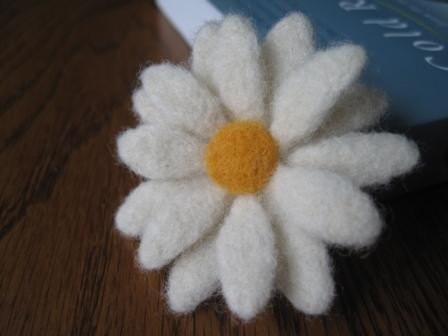 |
| Oxeye Daisy Bookmark by FeltLikeHelping |
Of course, people still wet felt, which is useful in creating pieces on a larger scale. In this process, the fibers are 'tangled' together by using moisture, heat, and agitation. Some of you may have inadvertently wet felted a nice wool sweater when you tossed it in the washer (oopps!). Welt felting can be done using either a previously knitted/crocheted item or using loose roving.
Chris Chunski has created this awesome Bacon! scarf by wet felting loose wool roving.
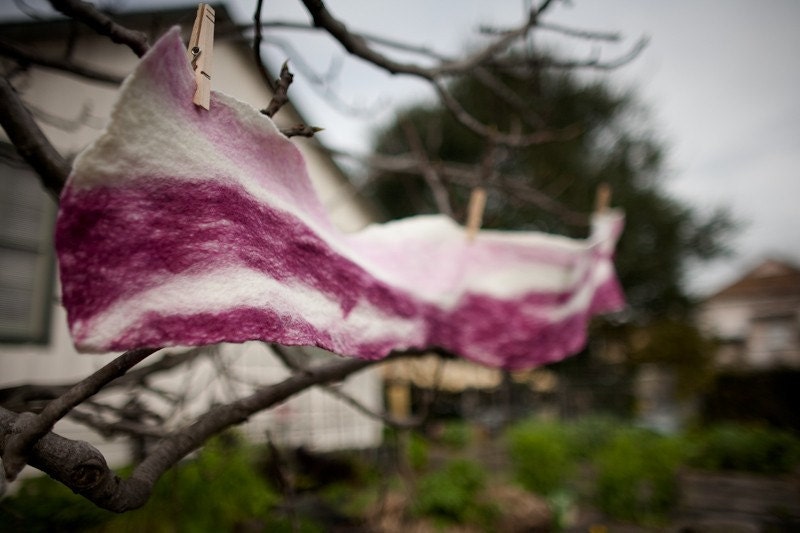 |
| We Felted Bacon Scarf by Chris Chunski |
Speaking of scarves, here are a couple of Bacon!y creations using a fiber art medium close to my heart, silk and dye. The first is from an fiber artist we have already gotten to know here, TeeGee.
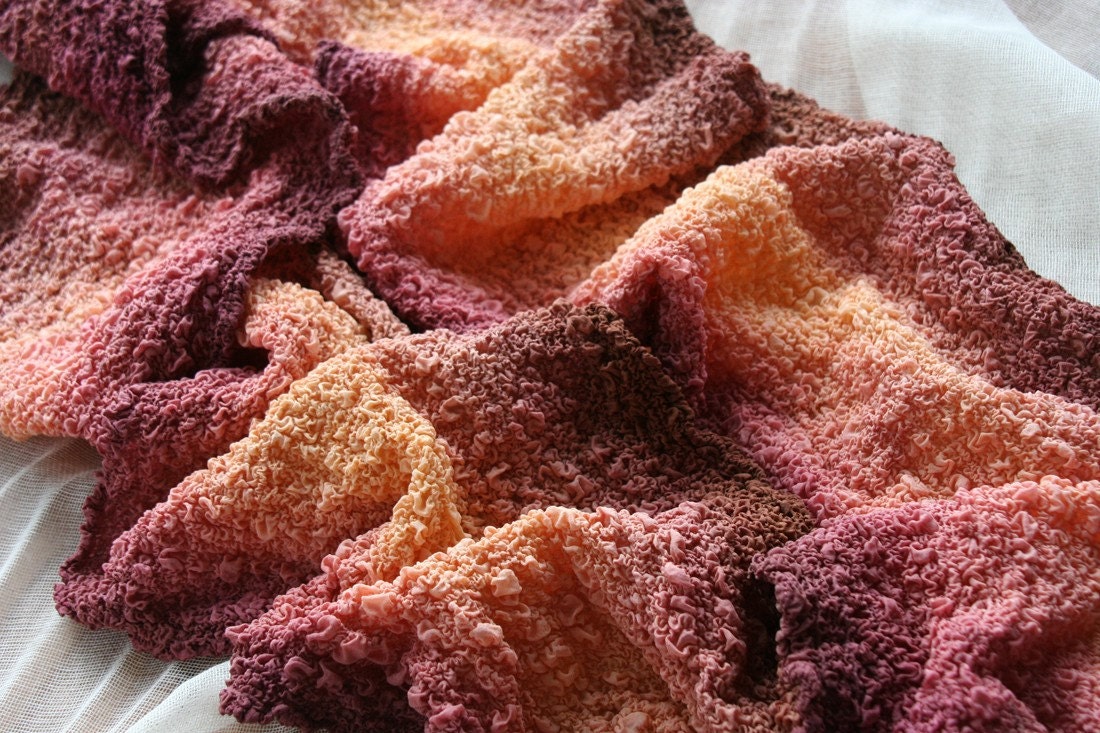 |
| Bubble Silk Bacon Scarf by TeeGee |
This scarf, handpainted by Crrysstall on Etsy, is a light and whimsical take on wearing your favorite food.
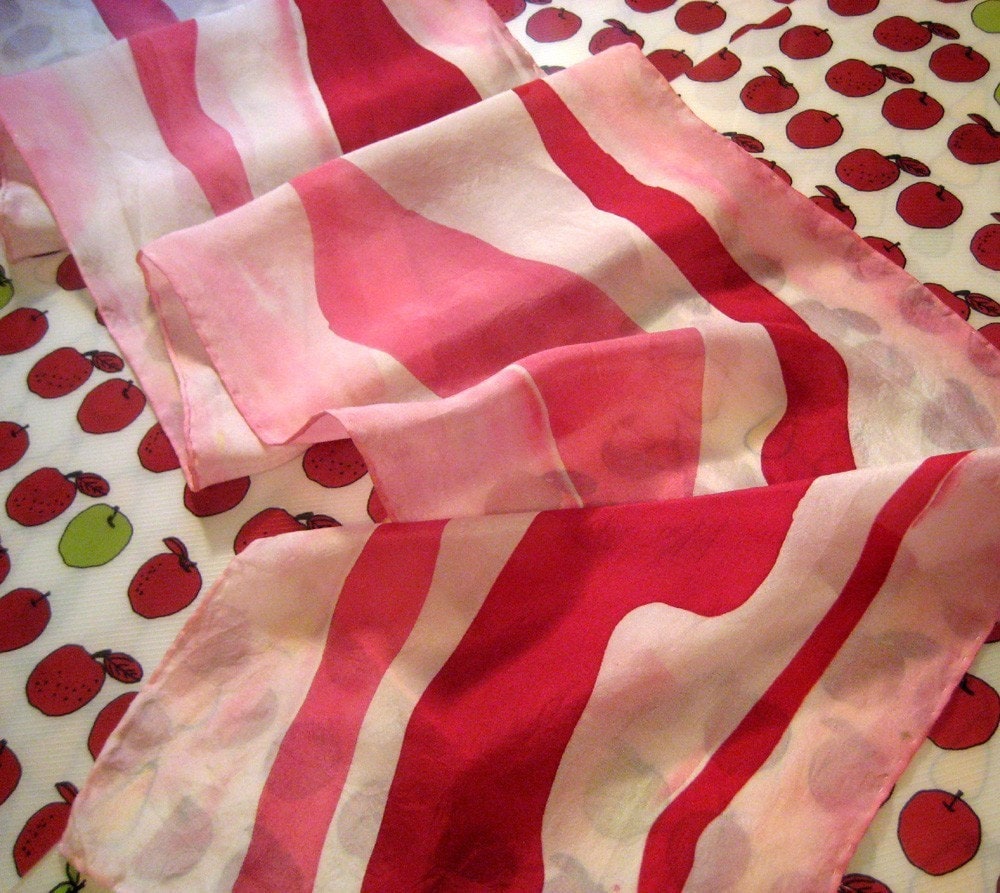 |
| Hand Painted Silk Bacon Scarf by Crrysstall |
O.K. (looks out the window to check outside), the Universe hasn't gone haywire because I've combined two of my favorite things in one blog post! All is good. Go forth, eat Bacon! and create!
Thursday, April 1, 2010
Team Bacon!
It's a craze that's sweeping the nation, Bacon! Well, o.k. not really. But if it did we would be a happier and more unified world. Bacon! brings people together. A perfect example is a group of us creative and slightly zany (boy, that's an understatement) Etsyians.
So, we've made our Bacon! solidarity official by joining forces and forming Team Bacon! Here's a few words from our fearless leader Allegro.
"So what does Team Bacon! do, and what do we have in store for the future?
Like any other Etsy team, our primary goal is to join together sellers with a common interest and use our collective talents to promote our work. But Team Bacon! is more than just that. We are a collection of very unusual, humorous, and highly talented crafters. We don't follow trends, we make them."
In a Bacon! powered frenzy we have created a Team blog, a Fan Page on Facebook, and we're on Twitter. It's amazing what a little bacony motivation can get accomplished in a little over a week!
The blog is simply wonderful. Not only can you find links to wonderful Etsy shops, but there are bacon recipes and a bit of trivia, to boot. We are also trying to team up with the charity organization SixDegrees.org to turn the power of Bacon! into a force for good.
Our last hurdle is to be officially recognized by Etsy so we can get our marketing into full swing. So, I say, "Free the Bacon!"
Oh, how could I forget the wonderful giveaways! Here is the current giveaway. A cute ACEO print by our own Moonstr.
 |
| Speck ist gut by Moonstr |
La gente, unido, siempre queiran tocino!
Labels:
allegro,
bacon,
Etsy,
moonstr,
six degrees,
Team Bacon
Subscribe to:
Posts (Atom)









